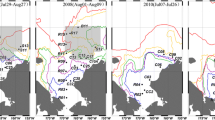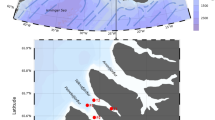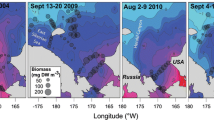Abstract
Inter-annual variations in zooplankton community structure in Prydz Bay were investigated using multivariate analysis based on samples collected with a 330-μm mesh, 0.5-m2 Norpac net during the austral summer from 1999 to 2006. Two distinct communities, an oceanic and a neritic community, were consistently identified in all surveys. Oceanic communities had higher diversity and were indicated by species such as Haloptilus ocellatus, Heterorhabdus austrinus, Thysanoessa macrura, Rhincalanus gigas, Scolecithricella minor and Oikopleura sp.. Neritic communities were indicated by Euphausia crystallorophias and Stephos longipes and were characterized by fewer but more abundant species. In 1999 and 2006, a transitional community was also distinguished near the continental shelf edge, where ice coverage was more extensive than either the oceanic or neritic regions. Significant inter-annual variations in community structure (mainly involving species abundance rather than species composition) were found in both oceanic and neritic communities, being more obvious in the latter. The timing and amplitude of sea ice retreat (polynya appearance), and its effect on food availability, had strong influences on zooplankton community structure. In oceanic communities during years with earlier ice retreat, the extra time available for phytoplankton blooms to accumulate resulted in a higher proportion of large copepods (Calanoides acutus, Calanus propinquus, Metridia gerlachei) (especially the younger copepodites) in the zooplankton assemblage. In neritic communities, zooplankton such as the ice krill E. crystallorophias, and large copepods (C. acutus, C. propinquus, M. gerlachei), also showed higher abundance and earlier developmental stages in years with larger polynya. On the other hand, in years with later ice retreat, smaller polynya, and less time for phytoplankton blooms to form, the abundance of large copepods was lower and older age classes were more common.







Similar content being viewed by others
References
Arrigo KR, Van Dijken GL (2003) Phytoplankton dynamics within 37 Antarctic coastal polynya systems. J Geophys Res 108(C8):3271
Arrigo KR, DiTullio GR, Dunbar RB, Lizotte MP, Robinson DH, Woert MV, Worthen DL (2000) Phytoplankton taxonomic variability and nutrient utilization and primary production in the Ross Sea. J Geophys Res 105:8827–8846
Atkinson A (1994) Diets and feeding selectivity among the epipelagic copepod community near South Georgia in summer. Polar Biol 14:551–560
Atkinson A (1998) Life cycle strategies of epipelagic copepods in the Southern Ocean. J Mar Syst 15:289–311
Atkinson A, Siegel V, Pakhomov E, Rothery P (2004) Long-term decline in krill stock and increase in salps within the Southern Ocean. Nature 432:100–103
Atkinson A, Siegel V, Pakhomov EA, Rothery P, Loeb V, Ross RM, Quetin LB, Schmidt K, Fretwell P, Murphy EJ, Tarling GA, Fleming AH (2008) Oceanic circumpolar habitats of Antarctic krill. Mar Ecol Prog Ser 362:1–23
Beaugrand G, Ibanez F, Lindley JA, Reid PC (2002) Diversity of calanoid copepods in the North Atlantic and adjacent seas: species associations and biogeography. Mar Ecol Prog Ser 232:179–195
Beaumont KL, Hosie GW (1997) Mesoscale distribution and abundance of four pelagic copepod species in Prydz Bay. Antarct Sci 9(2):121–133
Budnichenko EV (1994) Changes in the age composition of dominant copepod species in the Cooperation Sea (Antarctica) in 1977–1990. Oceanology 34(2):225–231
Burghart SE, Hopkins TL, Vargo GA, Torres JJ (1999) Effects of a rapidly receding ice edge on the abundance, age structure and feeding of three dominant calanoid copepods in the Weddell Sea, Antarctica. Polar Biol 22:279–288
Chiba S, Ishimaru T, Hosie GW, Fukuchi M (2001) Spatio-temporal variability of zooplankton community structure off east Antarctica (90 to 160°E). Mar Ecol Prog Ser 216:95–108
Clarke KR, Ainsworth M (1993) A method of linking multivariate community structure to environmental variables. Mar Ecol Prog Ser 92:205–219
Clarke A, Murphy EJ, Meredith MP, King JC, Peck LS, Barnes DKA, Smith RC (2007) Climate change and the marine ecosystem of the western Antarctic Peninsula. Phil Trans R Soc B 362:149–166
Constable AJ, Nicol S, Strutton PG (2003) Southern Ocean productivity in relation to spatial and temporal variation in the physical environment. J Geophys Res 108(C4):8079
Cook AJ, Fox AJ, Vaughan DG, Ferrigno JG (2005) Retreating glacier fronts on the Antarctic Peninsula over the past half-century. Science 308:541–544
Davis AJ, Lawton JH, Shorrocks B, Jenkinson LS (1998) Individualistic species responses invalidate simple physiological models of community dynamics under global environment change. J Anim Ecol 67:600–612
Dennett MR, Mathot S, Caron DA, Smith WO Jr, Lonsdale DJ (2001) Abundance and distribution of phototrophic and heterotrophic nano- and microplankton in the southern Ross Sea. Deep Sea Res II 48:4019–4037
Dubischar CD, Lopes RM, Bathmann (2002) High summer abundances of small pelagic copepods at the Antarctic Polar Front: implications for ecosystem dynamics. Deep Sea Res II 49:3871–3887
Dufrene M, Legendre P (1997) Species assemblages and indicator species: the need for a flexible asymmetrical approach. Ecol Monogr 67:345–366
Errhif A, Razouls C, Mayzaud P (1997) Composition and community structure of pelagic copepods in the Indian sector of the Antarctic Ocean during the end of the austral summer. Polar Biol 17:418–430
Field JG, Clarke KR, Warwick RM (1982) A practical strategy for analyzing multispecies distribution patterns. Mar Ecol Prog Ser 8:37–52
Fisher EC, Kaufmann RS, Smith KL (2004) Variability of epipelagic macrozooplankton/macrinekton community structure in the NW Weddell Sea, Antarctic (1995–1996). Mar Biol 144:345–360
Froneman PW, Pakhomov EA, Perissinotto R, Laubscher RK, McQuaid CD (1997) Dynamics of the plankton communities of the Lazarev Sea (Southern Ocean) during seasonal ice melt. Mar Ecol Prog Ser 149:201–214
Hansen JE, Ruedy R, Glascoe J, Sato M (1999) GISS analysis of surface temperature change. J Geophys Res 104(D24):30997–31022
Hays GC, Rihardson AJ, Robinson C (2005) Climate change and marine plankton. Trends Ecol Evol 20(6):337–344
Hopkins TL, Torres JJ (1988) The zooplankton community in the vicinity of the ice edge, western Weddell Sea, March 1986. Polar Biol 9:79–87
Hosie GW (1994) The macrozooplankton communities in the Prydz Bay region, Antarctica. In: El-Sayed SZ (ed) Southern Ocean ecology: the BIOMASS perspective. Cambridge University Press, Cambridge, pp 93–123
Hosie GW, Cochran TG (1994) Mesoscale distribution patterns of macrozooplankton communities in Prydz Bay, Antarctica—January to February 1991. Mar Ecol Prog Ser 106:21–39
Hosie GW, Cochran TG, Pauly T, Beaumont KL, Wright SW, Kitchener JA (1997) Zooplankton community structure of Prydz Bay, Antarctic, January-February 1993. Proc NIPR Symp Polar Biol 10:90–133
Hosie GW, Schultz MB, Kitchener JA, Cochran TG, Richards K (2000) Macrozooplankton community structure off east Antarctica (80–150°E) during the austral summer of 1995/1996. Deep Sea Res II 47:2437–2464
Hunt BPV, Pakhomov EA, McQuaid CD (2001) Short-term variation and long-term changes in the oceanographic environment and zooplankton community in the vicinity of a sub-Antarctic archipelago. Mar Biol 138:369–381
Hunt BPV, Pakhomov EA, Trotsenko BG (2007) The macrozooplankton of the Cosmonaut Sea, east Antarctica (30–60°E), 1987–1990. Deep Sea Res I 54:1042–1069
Karnovsky N, Ainley DG, Lee P (2007) The impact and importance of production in polynyas to top-trophic predators: three case histories. In: Smith WO Jr, Barber DG (eds) Polynyas: windows to the world. Elsevier, Amsterdam, pp 391–410
Loeb V (2007) Environmental variability and the Antarctic marine ecosystem. In: Vasseur DA, McCann KS (eds) The impact of environmental variability on ecological systems. Springer, Dordrecht, pp 197–225
Moline MA, Claustre H, Frazer TK, Schofield O, Vernet M (2004) Alternation of the food web along the Antarctic Peninsula in response to a regional warming trend. Global Change Biol 10:1973–1980
Molinero JC, Ibanez F, Nival P (2005) North Atlantic climate and northwestern Mediterranean plankton variability. Limnol Oceanogr 50(4):1213–1220
Nicol S, Pauly T, Bindoff NL, Wright S, Thiele D, Hosie GW, Strutton PG, Woehler E (2000) Ocean circulation off east Antarctica affects ecosystem structure and sea-ice extent. Nature 406:504–507
Pakhomov EA (1993) The faunistic complexes of macroplankton in the Cooperation Sea (Antarctica). Antarctica (32): 94–110 (in Russian)
Pakhomov EA, Froneman PW (2004) Zooplankton dynamics in the eastern Atlantic sector of the Southern Ocean during the austral summer 1997/1998—Part I: community structure. Deep Sea Res II 51:2599–2616
Pakhomov EA, Perissinotto R (1996) Antarctic neritic krill Euphausia crystallorophias: spatio-temporal distribution, growth and grazing rates. Deep Sea Res I 43:59–87
Pakhomov EA, Froneman PW, Perissinotto R (2002) Salp/krill interactions in the Southern Ocean: spatial segregation and implications for the carbon flux. Deep Sea Res II 49:1881–1907
Pu S, Dong Z (2003) Progress in physical oceanographic studies of Prydz Bay and its adjacent oceanic area. Chin J Polar Res 15:53–64 (in Chinese)
Rutherford S, D’Hondt S, Prell W (1999) Environmental controls on the geographic distribution of zooplankton diversity. Nature 400:749–753
Smetacek V, Nicol S (2005) Polar ocean ecosystems in a changing world. Nature 437:362–368
Smith NR, Dong Z, Kerry KR, Wright S (1984) Water masses and circulation in Prydz Bay, Antarctic. Deep Sea Res 31(1):1121–1147
Smith RC, Martinson DG, Stammerjohn SE, Iannuzzi RA, Ireson K (2008) Bellingshausen and western Antarctic Peninsula region: pigment biomass and sea-ice spatial/temporal distributions and interannual variability. Deep Sea Res II 55:1949–1963
Sugimoto T, Tadokoro K (1997) Interannual-interdecadal variations in zooplankton biomass, chlorophyll concentration and physical environment in the subarctic Pacific and Bering Sea. Fish Oceanogr 6:74–93
Swadling KM, Gibson JAE, Ritz DA, Nichols PD, Hughes DE (1997) Grazing of phytoplankton by copepods in eastern Antarctic coastal waters. Mar Biol 128:39–48
Taylor AH, Allen JI, Clark PA (2002) Extraction of a weak climate signal by an ecosystem. Nature 416:629–632
Thomas PG, Green K (1988) Distribution of Euphausia crystallorophias within Prydz Bay and its importance to the inshore marine ecosystem. Polar Biol 8:327–331
Turner J, Colwell SR, Marshall GJ, Lachlan-Cope TA, Carleton AM, Jones PD, Lagun V, Reid PA, Iagovkina S (2005) Antarctic climate change during the last 50 years. Int J Climatol 25:279–294
Williams WJ, Carmack EC, Ingram RG (2007) Physical oceanography of polynyas. In: Smith WO Jr, Barber DG (eds) Polynyas: windows to the world. Elsevier, Amsterdam, pp 55–86
Yuan XJ, Martinson DG (2000) Antarctic sea ice extent variability and its global connectivity. J Climate 13:1697–1717
Zwally HJ (1994) Detection of change in Antarctic. In: Hempel G (ed) Antarctic science: global concerns. Springer, Berlin, pp 126–143
Zwally HJ, Comiso JC, Parkinson CL, Cavalieri DJ, Gloersen P (2002) Variability of Antarctic sea ice 1979–1998. J Geophys Res 107(C5):3041
Acknowledgments
Thanks are due to all those who aided the collection of this data set: Y. Zhang, G. Zhang, H. Liu, P. Ji as well as the captain and crew of the RV ‘Xuelong’. We would like to thank NOAA for providing the sea ice data. We are also grateful to J. Shi for providing the temperature and salinity data and to C. Hu for the chlorophyll a data. Thanks also go to Dr. Angus Atkinson and Dr. Astrid Cornils for the help in species identification. Dr A. Atkinson, two anonymous referees and Editor In Chief Dieter Piepenburg substantially improved the final version of the manuscript. This research was supported by NSFC project (No. 40821004), National Key Technologies R&D Program of China (No. 2006BAB18B07) and the China IPY program.
Author information
Authors and Affiliations
Corresponding author
Electronic supplementary material
Below is the link to the electronic supplementary material.
Rights and permissions
About this article
Cite this article
Yang, G., Li, C. & Sun, S. Inter-annual variation in summer zooplankton community structure in Prydz Bay, Antarctica, from 1999 to 2006. Polar Biol 34, 921–932 (2011). https://doi.org/10.1007/s00300-010-0948-z
Received:
Revised:
Accepted:
Published:
Issue Date:
DOI: https://doi.org/10.1007/s00300-010-0948-z




